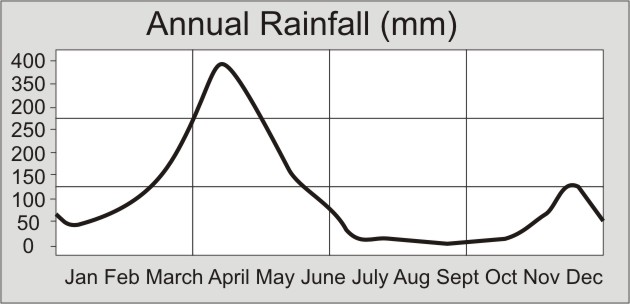Weather on Kilimanjaro
Mount Kilimanjaro sits just south of the equator, so it shouldn’t come as much of a surprise that temperatures at the base of the mountain are fairly constant all year round. Places near the equator all have dry seasons and rainy seasons in place of summer and winter etc. Some times of the year are far better than others in terms of weather, and that information can be found on the When to Go page.

Moshi weather
With an altitude of around 2,900 feet (890 meters) above sea level, Moshi sits at the base of the mountain and has mild weather most of the time, especially during the dry seasons. Daytime highs are normally around 80 F. (27 C.) and nighttime lows don’t usually go much below 70 F. (21 C.) or so. You’ll have a jacket along with you for the climb itself, but you won’t get much use out of it while in Moshi.
Annual Average Rainfall and Temperature as measured in Arusha – Tanzania
Weather on the mountain
When you reach the gate for your climb you’ll be in the neighborhood of 5,000 feet (1,500 meters) and daytime temperatures are usually lower than in Moshi, but rarely extreme. You’ll want your jacket handy, even if you aren’t wearing it every moment.
The weather on the climb itself can be highly unpredictable, even during the dry seasons. Again, see the when to go page for detailed information on that, but generally speaking you’ll be warm enough while climbing during the day that you won’t need to wear a jacket to stay warm, but it’s a different story at night.
On your first few nights the mercury will dip to near freezing after the sun goes down, and as you get closer to the summit itself the temperatures regularly drop a bit below freezing at night. You’ll obviously want to bring good mountain clothing because almost half your time during your climb will be spent in the cold.
Weather on the summit
You’ll start climbing around midnight on summit day, so obviously it will be very cold. You’ll get to the summit around the time the sun rises (around 6 a.m. every day of the year) and the sky tends to be clear for a couple hours. Though early mornings are usually clear, there is always snow at the summit so expect very cold temperatures even after the sun rises there.
Not long after you experience a clear sunrise, the clouds usually roll in and the weather can get bad in a hurry. This is one reason climbers only tend to spend 30 to 40 minutes at the summit celebrating their accomplishment before heading back down to get clear of the oncoming storm.

